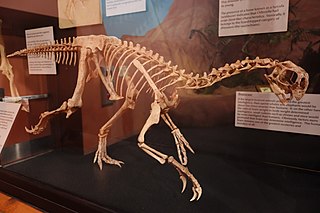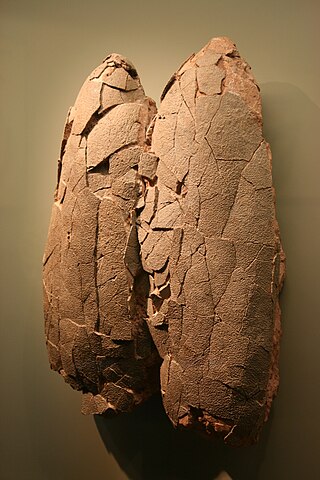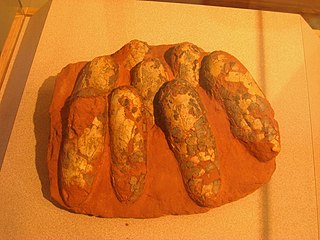
Heyuannia is a genus of oviraptorid dinosaur that lived in Asia during the Late Cretaceous epoch, in what is now China and Mongolia. It was the first oviraptorid found in China; most others were found in neighbouring Mongolia. Two species are known: H. huangi, named by Lü Junchang in 2002 from the Dalangshan Formation; and H. yanshini, originally named as a separate genus Ingenia from the Barun Goyot Formation by Rinchen Barsbold in 1981, and later renamed to Ajancingenia in 2013 due to the preoccupation of Ingenia. The latter name was eventually discarded due to various ethical issues surrounding the author.

Nemegtomaia is a genus of oviraptorid dinosaur from what is now Mongolia that lived in the Late Cretaceous Period, about 70 million years ago. The first specimen was found in 1996, and became the basis of the new genus and species N. barsboldi in 2004. The original genus name was Nemegtia, but this was changed to Nemegtomaia in 2005, as the former name was preoccupied. The first part of the generic name refers to the Nemegt Basin, where the animal was found, and the second part means "good mother", in reference to the fact that oviraptorids are known to have brooded their eggs. The specific name honours the palaeontologist Rinchen Barsbold. Two more specimens were found in 2007, one of which was found on top of a nest with eggs, but the dinosaur had received its genus name before it was found associated with eggs.

Nanshiungosaurus is a genus of therizinosaurid that lived in what is now Asia during the Late Cretaceous of South China. The type species, Nanshiungosaurus brevispinus, was first discovered in 1974 and described in 1979 by Dong Zhiming. It is represented by a single specimen preserving most of the cervical and dorsal vertebrae with the pelvis. A supposed and unlikely second species, "Nanshiungosaurus" bohlini, was found in 1992 and described in 1997. It is also represented by vertebrae but this species however, differs in geological age and lacks authentic characteristics compared to the type, making its affinity to the genus unsupported.

Banji is an extinct genus of oviraptorid dinosaur that lived approximately 66 million years ago during the later part of the Cretaceous Period in what is now China. It was a small, lightly built, ground-dwelling, bipedal carnivore, that was an estimated 65 cm (2.1 ft) long, as a juvenile.

Elongatoolithus is an oogenus of dinosaur eggs found in the Late Cretaceous formations of China and Mongolia. Like other elongatoolithids, they were laid by small theropods, and were cared for and incubated by their parents until hatching. They are often found in nests arranged in multiple layers of concentric rings. As its name suggests, Elongatoolithus was a highly elongated form of egg. It is historically significant for being among the first fossil eggs given a parataxonomic name.

Luoyanggia is a genus of oviraptorid dinosaur known from the Early Cretaceous Haoling Formation of the Ruyang Basin in Henan Province, central China. The type species is L. liudianensis. Holtz estimated it at 1.5 meters and around 2.27-9.1 kg. Molina-Pérez and Larramendi gave a similar size of 1.2 meters and 8.5 kg.
The Nanxiong Formation is a Late Cretaceous geologic formation in Guangdong Province. Dinosaur remains are among the fossils that have been recovered from the formation.

Macroelongatoolithus is an oogenus of large theropod dinosaur eggs, representing the eggs of giant caenagnathid oviraptorosaurs. They are known from Asia and from North America. Historically, several oospecies have been assigned to Macroelongatoolithus, however they are all now considered to be a single oospecies: M. carlylensis.

Macroolithus is an oogenus of dinosaur egg belonging to the oofamily Elongatoolithidae. The type oospecies, M. rugustus, was originally described under the now-defunct oogenus name Oolithes. Three other oospecies are known: M. yaotunensis, M. mutabilis, and M. lashuyuanensis. They are relatively large, elongated eggs with a two-layered eggshell. Their nests consist of large, concentric rings of paired eggs. There is evidence of blue-green pigmentation in its shell, which may have helped camouflage the nests.

The Qiupa Formation is a Late Cretaceous Maastrichtian geologic formation in Henan Province, central China. It is rich in dinosaur eggs and bones, such as those of carnivorous and herbivorous dinosaurs. The Qiupa Formation is considered to be Late Maastrichtian in age, about 72 million and 66 million years ago.

Ganzhousaurus is an extinct genus of oviraptorid dinosaur known from the Late Cretaceous Nanxiong Formation of Nankang County, Ganzhou City of Jiangxi Province, southern China. It was found in a Maastrichtian deposit and contains a single species, Ganzhousaurus nankangensis. It is distinguished by a combination of primitive and derived features.

Jiangxisaurus is an extinct genus of oviraptorid theropod dinosaur from the Late Cretaceous Nanxiong Formation of southern China. It was similar to Heyuannia, but with more strongly curved anterior claws and a thinner, frailer mandible. This find is paleontologically significant because it contributes to current knowledge about the paleogeographical distribution of oviraptorids in southern China. It was most likely a herbivorous animal along with its close relatives Nankangia and Ganzhousaurus.

Nankangia is an extinct genus of caenagnathoid oviraptorosaurian dinosaur known from the Upper Cretaceous Nanxiong Formation of Nankang County, Ganzhou City of Jiangxi Province, southeastern China. It contains a single species, Nankangia jiangxiensis. N. jiangxiensis coexisted with at least four other caenagnathoids, including but not limited to Corythoraptor, Banji, Ganzhousaurus and Jiangxisaurus. The relatively short dentary and non-downturned mandibular symphysis of Nankangia suggest that it may have been more herbivorous than carnivorous. Its diet consisted of leaves and seeds.

Qianzhousaurus is a genus of tyrannosaurid dinosaur that lived in Asia during the Maastrichtian age of the Late Cretaceous period. There is currently only one species named, the type species Qianzhousaurus sinensis, which is a member of the tribe Alioramini and most closely related to Alioramus, the only other known alioramin.

This timeline of oviraptorosaur research is a chronological listing of events in the history of paleontology focused on the oviraptorosaurs, a group of beaked, bird-like theropod dinosaurs. The early history of oviraptorosaur paleontology is characterized by taxonomic confusion due to the unusual characteristics of these dinosaurs. When initially described in 1924 Oviraptor itself was thought to be a member of the Ornithomimidae, popularly known as the "ostrich" dinosaurs, because both taxa share toothless beaks. Early caenagnathid oviraptorosaur discoveries like Caenagnathus itself were also incorrectly classified at the time, having been misidentified as birds.

Huanansaurus is an extinct genus of oviraptorid dinosaur that lived approximately 72 million years ago, between the Campanian and Maastrichtian, during the latter part of the Cretaceous period in what is now China, in the Nanxiong Formation.

Elongatoolithidae is an oofamily of fossil eggs, representing the eggs of oviraptorosaurs. They are known for their highly elongated shape. Elongatoolithids have been found in Europe, Asia, and both North and South America.

Tongtianlong is a genus of oviraptorid theropod dinosaurs that lived in the late Maastrichtian epoch of the late Cretaceous period. It contains one species, T. limosus.

Beibeilong is a genus of large caenagnathid dinosaurs that lived in Asia during the Late Cretaceous epoch, about 96 million to 88 million years ago. The genus contains a single species, Beibeilong sinensis. The species was named and described in 2017 through analysis of an embryonic skeleton and partial nest with large eggs that were discovered in the Gaogou Formation of China between 1992 and 1993.
Nanhsiungoolithus is an oogenus of dinosaur egg from the late Cretaceous of China. It belongs to the oofamily Elongatoolithidae, which means that it was probably laid by an oviraptorosaur, though so far no skeletal remains have been discovered in association with Nanhsiungoolithus. The oogenus contains only a single described oospecies, N. chuetienensis. It is fairly rare, only being know from two partially preserved nests and a few eggshell fragments.



















